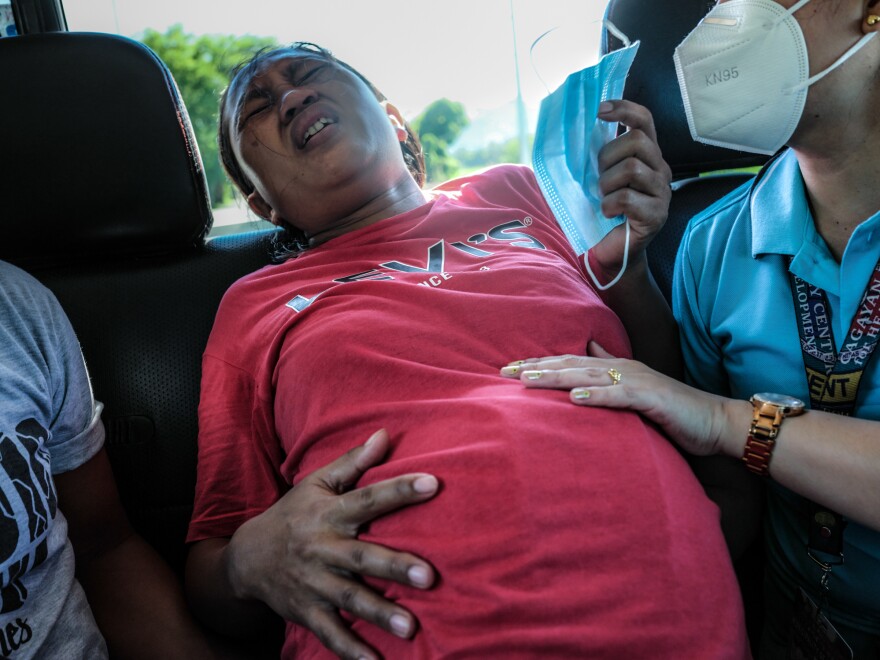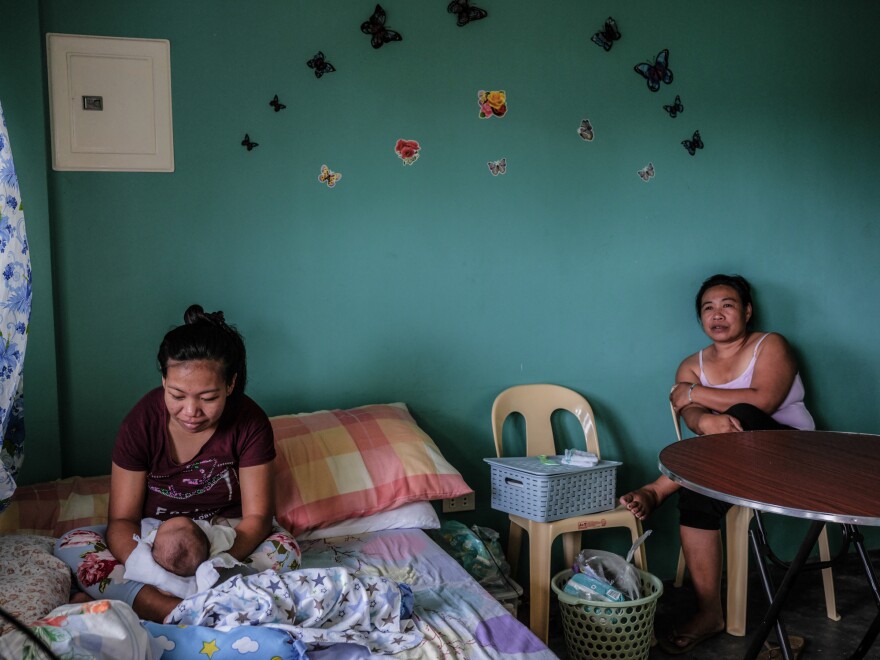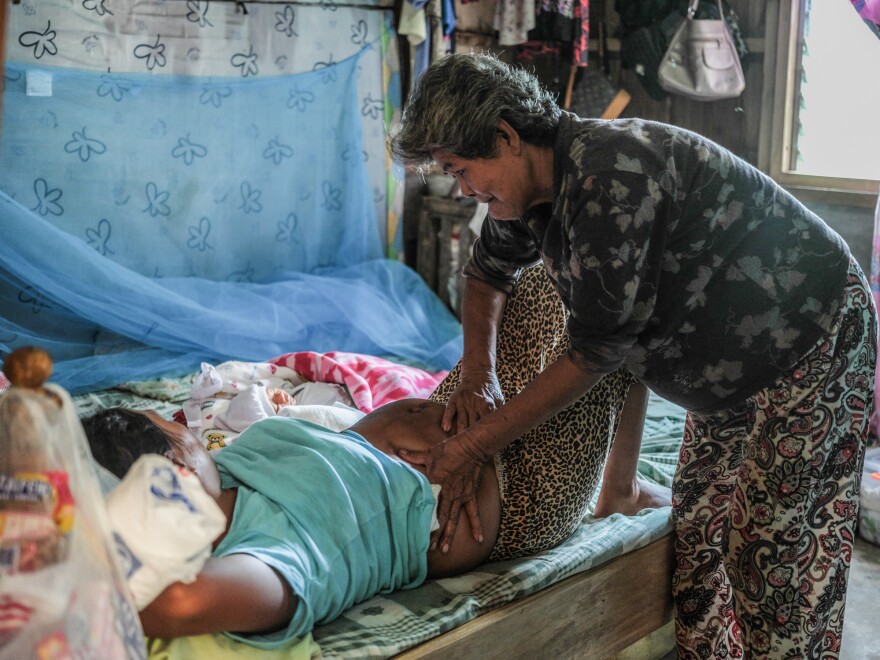Risa Calibuso, 34, wanted to give birth to her second child at home.
In the Philippines, where she lives, that's against the law.
In 2008 the country passed the Maternal, Newborn and Child Health and Nutrition Strategy policy — referred to as the "no home birth" policy. The goal was to reduce the country's high rates of maternal mortality, from 203 out of 100,000 live births that year to 52 by 2015.
It's a controversial law. Despite the good intentions, some local groups assert that it impinges on the rights of women.
What's more, the policy has not yet met its goal. In 2017, the maternal mortality rate in the Philippines was 121 deaths per 100,000 live births.
Nor has there been a significant change in the rates of infant mortality. In 2008, there were 25.5 deaths per 1,000 live births. In 2018, the figure was 22.5.
The pandemic of 2020 has made the policy even more controversial. In the past, women who live in remote areas have had to arrange for transportation to the nearest appropriate health-care facility. Now matters are even more complicated. With pandemic-related restrictions on transportation options like cabs and motorized tricycles, women who do not own a car have fewer choices.
Then again, the policy was complicated even before COVID-19 struck.
Some regions of the Philippines will fine a woman who gives birth at home when she comes to a hospital to register her baby. Other provinces do not fine the woman but may chastise her when she brings in her newborn to be registered.
Meanwhile, across the country, the law has had a chilling impact on midwives. If they assist at a home birth, they risk losing their accreditation.

As with many laws, those who are well-to-do can get around the restrictions. They would have to hire a private doctor to assist with a home birth, sterilize a birthing area in their residence and rent an ambulance on standby.
But for many women, this is hardly an option.
A mother's burden
The story of Risa Calibuso brings the many issues swirling around the policy into sharp focus.
Calibuso was expecting her second child in July. She lives with her family in Abinganan, a village of 1,700 people on rugged terrain in Bambang. Her husband, Michael, age 36, dries rice for a living and earns 345 pesos ($7) a day. She does not work and describes the family as "indigent." She and her husband do not own a car — they can't afford it.

To comply with the No Home Birth policy, she'd have to travel 11 miles – a trip of about an hour over rough roads – to the nearest clinic.
The Calibusos pay $73.94 a year for medical insurance, and yet she was worried that her insurance wouldn't cover all the expenses.
"Traditional birth attendants are cheaper," says Calibuso, who used an attendant when she delivered her first child at home. They are typically paid with tips amounting to the equivalent of about $10 — or higher if the family has a higher income.
What's more, Calibuso really wanted to give birth at home. She did it with her first child in 2007, before the policy went into effect, and she felt like that went OK.
So she did not arrange in advance for transportation to that clinic that was 11 miles away. When she went into labor at 8 p.m. on July 19, she figured she would call a midwife, Marissa Tuping, and retired birth attendant, Florida Domingo, in the morning and hope for the best.
She gambled – and lost. When the midwife and attendant came to her home, they found that Calibuso's water had already broken and she was spotting blood. Yet the midwife would not agree to help deliver the baby lest her own career be jeopardized.
Marissa Tuping, the midwife, says, "I can never pull the baby out. If there is a home birth, it will affect my performance review." Like many midwives, Tuping works under the Department of Health and must renew her contract with them every year. "I'm scared that if there is home birth on my record, I will lose my job," she says.
Calibuso's only option for medical care was to travel those 11 miles. A neighbor had a motorcycle, but it was unavailable. The last resort was the motorized tricycle, provided by the government for the village to use in emergencies like these; it was also not available.

This put me, as a journalist, in a difficult situation. I had arrived to photograph the birth; I traveled by car with a driver.
As a reporter, I am trained not to intervene in the lives of my subjects – but given the circumstance, I felt I had to offer to bring her to the hospital. The midwife came along and talked to Calibuso about how to breathe through the contractions.
Fortunately we made good time. Given that it was an emergency, we drove fast, and the drive took a little over a half an hour. A few minutes after arriving at the hospital, Calibuso gave birth to Heinrich Claude, a healthy baby boy.
Even though many women find the policy burdensome, the government stands by it. "Every birth, life is at risk — and as a doctor who knows the risks, I will not advocate for a home birth," says Dr. Agnes Bernabe, 47, an obstetrician and gynecologist. She works in a private clinic in Bambang and at Nueva Vizcaya Provincial Hospital and is a member of the committee that reviews maternal death in the province. "Home births and traditional healings [procedures done by a local healer after birth] are the usual causes of maternal and neonatal deaths."

Her concerns are backed up by data. According to the Department of Health, the majority of maternal deaths in the Philippines are a direct result of pregnancy complications that occur during labor and delivery and also from issues that arise in the post-partum period. When the policy was implemented in 2008, a little over half of births in the Philippines were at home. Only about a third of those take place with the assistance of traditional birth attendants (who are not medically trained). There are no comparable statistics regarding the role of midwives.
The policy, adds Bernabe, has helped mothers become "more informed now about the importance of seeing a doctor and hospital births."
Pandemic anxiety adds to the stress
Lockdown restrictions around public transportation — which in some villages, change every couple of weeks – is making it harder for women to get to a health facility.
Some mothers have had to rent an apartment before giving birth, creating an additional cost for them to bear.
"Our house is two hours away from the hospital, so we came down and rented an apartment two weeks before my due date," says Mylene Madawat, a 24-year-old mother from the upland municipality of Santa Fe who gave birth on July 24.

Madawat ended up delivering her 8-pound baby boy through a cesarean section at the hospital. Due to her surgery, she and her mother Minda, who came down from their village, needed to stay longer in the apartment they rent for 4,000 pesos ($82) plus utilities a month. And Madawat needed to finish her postpartum and neonatal check-ups. "This apartment is so expensive, we can't wait to go back home," she says.
"I'm scared of the virus, what if I get it from the hospital?" says Jessa Tayombong, a 32-year-old mother from Banggot, a village in the province of Nueva Vizcaya.
Even though she knew that home births aren't allowed, she delivered her daughter Josie at home on July 14 with the help of a neighbor, who had assisted women in their village with births before but was not a skilled birth attendant.
Luckily for Tayombong and the neighbor, their village has not enacted a financial penalty for home births. So when she registered the child's birth, she was only chastised by health-care workers and village officials. And to register the child she had to go to the hospital for a neonatal checkup. So in the end, she had to do what she feared and went to a health-care facility during the pandemic.

Pushing back against the policy
The Gabriela Women's Party, a grassroots organization that advocates for the rights of marginalized Filipino women, has been trying for years to get rid of the policy.
"The No Home Birth policy is against the rights of mothers," says the organization's deputy secretary-general Joan Salvador. "Women should be given all the necessary information and choices on how and where to give birth. Whether she wants to give birth at home or in a facility, the government should provide all the necessary support and services to ensure her safety and that of the child."
In 2014, Gabriela filed House Resolution 1531, a written motion to the Philippines Congress to challenge the No Home Birth policy and investigate the fines on women and health care workers.
It didn't pass, so Gabriela re-filed it in 2016 — but it was never brought up for debate.

Lynn Freedman, a professor of population and family health at Columbia University, agrees that a policy that punishes women for giving birth at home is not the way to go. "Criminalizing or outright banning home deliveries is a blunt, potentially rights-violating instrument for getting to the ultimate goal," she says.
Still, she adds, hospitals and health care facilities have a crucial role in reducing maternal mortality. "If a woman gets a serious obstetric complication during delivery, such as hemorrhage, her survival often depends on getting timely access to emergency obstetric care in a health facility or hospital that can save her life," she says.
"The way to get there has to be multidimensional," she adds. "The country may need to build more facilities, hire more staff who are properly trained and equipped, make sure people have a way to get to the hospital."

As for Risa Calibuso, she is at home with her newborn son. When I visited her, she was undergoing a traditional healing process from the Ilocana ethnic group with Florida Domingo, a retired birth attendant. The method includes binding the stomach with fabric for several days. In addition, the attendant administers early morning massage.
That's what she did after the birth of her first son.
"It is part of our culture," she says.
And she tells me she is very happy that the stress of giving birth is now behind her.

Xyza Cruz Bacani is a freelance photographer based in Southeast Asia and the author of the book We Are Like Air. She previously contributed to NPR for a story on babies born during the pandemic, in collaboration with Everyday Projects.
Copyright 2023 NPR. To see more, visit https://www.npr.org.



